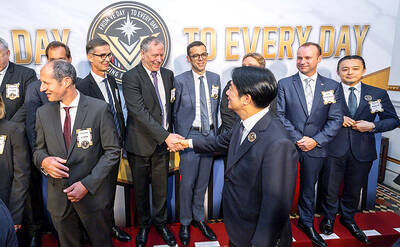Now you really can reach out and touch someone through the Internet, with the help of a wearable robot designed by a husband-and-wife team of scientists based in Japan.
Five years in the making, the device aims to inject a little physicality into online chatter, boosting the emotional quotient of virtual exchanges between flesh-and-blood people.
Forget emoticons, those annoying little smiley :-) or frowning :-( faces added to text messages with key strokes.
SENSATION
The quickened thump of an angry heart beat, a spine-tingling chill of fear, or that warm-all-over sensation sparked by true love — all can be felt even as your eyes stay glued to a computer screen.
The proof-of-concept robot, dubbed iFeel_IM! (“I feel therefore I am”), was presented this month at the first Augmented Human International Conference, held in the French Alps ski resort of Megeve.
A two-day gathering of engineers and scientists, many from Japan, compared notes on cutting edge research in a field called augmented reality, the realtime enhancement of experience through virtual, interactive technology.
Smartphones that tell you not just where you are but what you are looking at, or Terminator-like visual overlays of data for soldiers in battle are both examples.
Several research teams in Megeve also unveiled breakthroughs in the use of brain waves — captured by electrodes placed on the head — to operate computers or decipher emotions.
HUMAN-LIKE
However, Dzmitry Tsetserukou, an assistant professor at Toyohashi University of Technology in Japan, said his aim was to boost feeling, to add a human-like sense of touch to the incorporeal ether of cyberspace.
“We are steeped in computer-mediated communication — SMS, e-mail, Twitter, instant messaging, 3D virtual worlds — but many people don’t connect emotionally,” he said in an interview.
“I am looking to create a deep immersive experience, not just a vibration in your shirt triggered by an SMS. Emotion is what gives communication life,” he said.
For now, his prototype robot is a collection of sensors, small motors, vibrators and speakers woven into a series of straps similar to a parachute harness, minus the parachute.
Connected to a computer, the device can simulate several types of heart beat, a realistic hug, the tickling sensation of a butterfly stomach and a tingling feeling along the spine. It can also generate warmth.
While he could have added a mechanism for sexual arousal, Tsetserukou decided doing so would ultimately distract from his focus on emotion boosting.
Software written by his colleague — and wife — Alena Neviarouskaya, a researcher at the University of Tokyo, ferrets out the emotional messages embedded in written text, triggering the appropriate touch sensation in the robot in real time.
It distinguishes joy, fear, anger and sadness with 90 percent accuracy and can parse nine emotions — adding shame, guilt, disgust, interest and surprise — nearly four out of five times, a peer-review study presented at the conference said.
“This is really state of the art, there is nothing this accurate,” Tsetserukou said.
Subjects tested the system in the online, three-dimensional environment known as Second Life, inhabited by avatars manipulated by individuals sitting before their computers.
AVATARS
In a demonstration, two people wearing iFeel_IM! robots communicated at distance through the medium of their avatars.
The words “I am happy to see you” triggers a warm sensation in the person spoken to and as the avatars hug in their virtual world, the act is mirrored in reality by a squeezing sensation around the waist.
Tsetserukou compared the system to the blockbuster Avatar, and especially the film Surrogates, set in a future when humans stay at home plugged into a cocoon while their healthier, more handsome doppelgangers venture forth into the real world.
“In a few years, this could be a mobile system integrated into a suit or jacket,” he said. “It’s not that far away.”

DEFENDING DEMOCRACY: Taiwan shares the same values as those that fought in WWII, and nations must unite to halt the expansion of a new authoritarian bloc, Lai said The government yesterday held a commemoration ceremony for Victory in Europe (V-E) Day, joining the rest of the world for the first time to mark the anniversary of the end of World War II in Europe. Taiwan honoring V-E Day signifies “our growing connections with the international community,” President William Lai (賴清德) said at a reception in Taipei on the 80th anniversary of V-E Day. One of the major lessons of World War II is that “authoritarianism and aggression lead only to slaughter, tragedy and greater inequality,” Lai said. Even more importantly, the war also taught people that “those who cherish peace cannot

Taiwanese Olympic badminton men’s doubles gold medalist Wang Chi-lin (王齊麟) and his new partner, Chiu Hsiang-chieh (邱相榤), clinched the men’s doubles title at the Yonex Taipei Open yesterday, becoming the second Taiwanese team to win a title in the tournament. Ranked 19th in the world, the Taiwanese duo defeated Kang Min-hyuk and Ki Dong-ju of South Korea 21-18, 21-15 in a pulsating 43-minute final to clinch their first doubles title after teaming up last year. Wang, the men’s doubles gold medalist at the 2020 and 2024 Olympics, partnered with Chiu in August last year after the retirement of his teammate Lee Yang

The Philippines yesterday criticized a “high-risk” maneuver by a Chinese vessel near the disputed Scarborough Shoal (Huangyan Island, 黃岩島) in a rare incident involving warships from the two navies. The Scarborough Shoal — a triangular chain of reefs and rocks in the contested South China Sea — has been a flash point between the countries since China seized it from the Philippines in 2012. Taiwan also claims the shoal. Monday’s encounter took place approximately 11.8 nautical miles (22km) southeast” of the Scarborough Shoal, the Philippine military said, during ongoing US-Philippine military exercises that Beijing has criticized as destabilizing. “The Chinese frigate BN 554 was

US Secretary of the Treasury Scott Bessent and US Trade Representative Jamieson Greer began talks with high-ranking Chinese officials in Switzerland yesterday aiming to de-escalate a dispute that threatens to cut off trade between the world’s two biggest economies and damage the global economy. The US delegation has begun meetings in Geneva with a Chinese delegation led by Chinese Vice Premier He Lifeng (何立峰), Xinhua News Agency said. Diplomats from both sides also confirmed that the talks have begun, but spoke anonymously and the exact location of the talks was not made public. Prospects for a major breakthrough appear dim, but there is